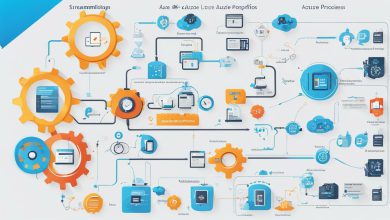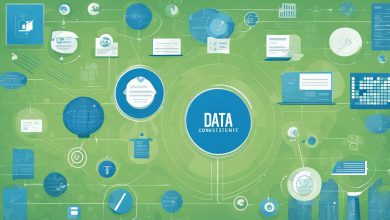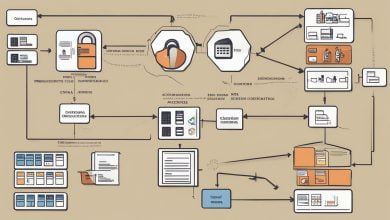
Welcome to our article on modern trends in identity management, where we explore how Single Sign-On (SSO) has evolved into Multi-Factor Authentication (MFA) to provide more secure and efficient access management. In today’s digital landscape, identity management has become crucial to safeguarding sensitive data and preventing cyber threats. With the rise in remote work and cloud-based applications, it is more important than ever to have a robust identity management system in place.
In this article, we will discuss the benefits and challenges of SSO, the emergence of MFA as a more secure authentication method, and the innovative approaches to passwordless authentication. We will also explore the growing importance of biometric authentication and the evolution of Identity and Access Management (IAM) solutions.
Key Takeaways
- Identity management is crucial in today’s digital landscape to prevent cyber threats and safeguard sensitive data.
- SSO allows users to access multiple applications and systems with just one set of login credentials.
- MFA provides more secure authentication by verifying user identities with multiple factors.
- Passwordless authentication is an innovative approach to identity management that eliminates the need for passwords.
- Biometric authentication is becoming increasingly important as a key component of MFA.
- IAM solutions have evolved to provide more comprehensive identity management capabilities, integrating SSO and MFA.
Understanding Single Sign-On (SSO)
In today’s digital landscape, managing access to various applications and systems can become complex and frustrating for users. This is where Single Sign-On (SSO) comes in. SSO is an Identity and Access Management (IAM) solution that allows users to access multiple applications and systems with just one set of login credentials, simplifying the login process and enhancing user experience.
SSO works by authenticating users only once, upon accessing the first application or system. Once authenticated, SSO generates a token that the user can use to access other applications and systems without having to re-enter their login credentials. This eliminates the need for users to remember multiple sets of login credentials or to log in separately into each application or system.
One of the main benefits of SSO is that it simplifies access management for system administrators. Instead of managing access separately for each application or system, administrators can manage access through a centralized IAM solution. This reduces the risk of errors and saves time and effort in managing access.
However, SSO also comes with some challenges. One of the biggest challenges is that if the SSO credentials are compromised, an attacker can gain access to multiple applications and systems, not just one. This is why it is important to implement additional security measures such as Multi-Factor Authentication (MFA) alongside SSO.
Overall, SSO is a modern trend in identity management that enhances user experience and simplifies access management. As digital resources continue to expand, the importance of SSO in maintaining secure access will only continue to grow.
The Rise of Multi-Factor Authentication (MFA)
As cyber threats become more sophisticated, traditional authentication methods such as passwords are no longer sufficient to protect sensitive data. In response, Multi-Factor Authentication (MFA) has emerged as a more secure authentication method.
MFA uses multiple authentication factors such as passwords, tokens, biometrics, and more, to verify user identities. By adding an extra layer of security, MFA helps to mitigate the risks of unauthorized access and data breaches.
The most common MFA methods are:
- Passwords and security questions
- Hardware tokens and smart cards
- One-time passcodes (OTPs) sent via SMS or email
- Biometrics, such as fingerprint or facial recognition
The combination of these factors ensures that only authorized users have access to sensitive data and resources. Furthermore, MFA helps to ensure compliance with regulatory requirements, such as the General Data Protection Regulation (GDPR) and the Payment Card Industry Data Security Standard (PCI DSS).
As more businesses adopt MFA as a standard practice, it is clear that the trend towards stronger identity management solutions will continue to grow.
Passwordless Authentication: A Step Forward in Identity Management
With the increasing need for secure digital authentication, passwordless authentication has emerged as a modern trend in identity management. This innovative approach eliminates the need for traditional passwords and instead utilizes various authentication methods for user verification.
One of the most popular methods of passwordless authentication is biometric authentication, which uses unique physical characteristics such as fingerprints, facial recognition, and iris scans to verify user identity. Push notifications and FIDO (Fast Identity Online) standards are other examples of passwordless authentication that have gained attention for their improved security and ease of use.
Passwordless authentication not only strengthens security but also enhances user experience by eliminating the need for multiple passwords and simplifying the authentication process. This approach has gained momentum in recent years and is becoming increasingly popular among businesses and consumers alike as a more secure and convenient way of managing digital identities.
As organizations continue to prioritize security in their digital operations, passwordless authentication is likely to become a standard practice in the near future. By staying up-to-date with modern trends in identity management, businesses can ensure the security of their digital resources while providing a seamless user experience for their customers and employees.
The Role of Biometric Authentication in Modern Identity Management
Biometric authentication has emerged as a key player in modern identity management, offering a more secure and user-friendly alternative to traditional password-based methods. Biometric authentication uses unique biological characteristics such as fingerprints, facial features, and iris scans to verify a user’s identity.
One of the main advantages of biometric authentication is its ability to provide robust authentication as part of a Multi-Factor Authentication (MFA) solution. By combining biometric authentication with other factors such as passwords or tokens, MFA provides an additional layer of security against unauthorized access. Biometric authentication also eliminates the need for users to remember multiple passwords, simplifying the login process and reducing the risk of weak or reused passwords.
However, like any authentication method, biometric authentication has its limitations. Biometric data can be susceptible to breaches, and in some cases, biometric authentication systems may produce false positives or negatives, leading to denied access or unauthorized entry. It is essential to implement proper security measures, such as encryption and secure storage of biometric data to ensure the protection of sensitive information.
| Biometric Technology | Strengths | Limitations |
|---|---|---|
| Fingerprint Recognition | Widely available on mobile devices. Highly accurate and reliable. | Possibility of copies or spoofs. Not ideal for individuals with skin conditions or injuries that affect fingerprint patterns. |
| Facial Recognition | Easy to use and non-intrusive. Can work with existing surveillance systems to monitor for potential threats. | Security risks related to data privacy and facial recognition technology’s potential for misuse. Possible issues with accuracy and bias. |
| Iris Scans | Highly secure and reliable, providing accurate and unique identification. | Can be challenging for some individuals to use due to certain medical conditions or eye abnormalities. |
In conclusion, biometric authentication has become an essential component of modern identity management, providing more secure, convenient, and user-friendly authentication methods. While biometric authentication is not without its limitations, proper implementation and management can provide an additional level of security in conjunction with Multi-Factor Authentication.
Evolving Identity and Access Management Solutions
Identity and Access Management (IAM) solutions have come a long way from their early days as basic authorization tools. Today’s modern IAM systems have integrated Single Sign-On (SSO) and Multi-Factor Authentication (MFA) capabilities, providing more comprehensive and robust identity management solutions.
With the evolution of digital technology, identity management has become an increasingly complex challenge for organizations. IAM solutions have stepped up to the challenge, offering more features and functionalities to address the changing landscape of identity management. SSO, the concept of allowing users to access multiple applications and systems with just one set of login credentials, has become a foundational component of modern IAM systems. It simplifies access management and enhances user experience by reducing the number of times a user has to enter their credentials.
MFA has emerged as a more secure authentication method, using multiple factors to verify user identities. Biometrics, tokens, and smartcards are just a few examples of the authentication factors that IAM systems can incorporate. The integration of MFA with IAM solutions has significantly reduced the risks of unauthorized access and data breaches.
Today’s modern IAM solutions are designed to be more user-friendly, convenient, and accessible. They provide self-service options for password resets and user profile management, freeing up IT staff to focus on more high-level tasks. IAM solutions also offer audit trail capabilities, enabling organizations to monitor and analyze user activity for compliance and security purposes.
With the increasing importance of identity management in today’s digital landscape, organizations cannot afford to overlook the importance of modern IAM solutions. They offer advanced security features and user conveniences that improve overall organizational efficiency. By integrating SSO and MFA capabilities, modern IAM solutions provide a comprehensive approach to identity and access management that ensures secure access to digital resources.
Conclusion
In today’s digital landscape, identity management has become increasingly crucial, and modern trends are moving towards multi-layered security measures. Single Sign-On (SSO) has simplified access management and enhanced user experience, while Multi-Factor Authentication (MFA) has emerged as a more secure authentication method. Passwordless authentication is also gaining traction as an innovative approach to identity management, offering better security and user convenience.
Biometric authentication, with its use of unique human characteristics, has become a key component of MFA and has shown potential in enhancing security. As identity and access management solutions evolve, they integrate SSO and MFA capabilities to provide a more comprehensive approach to identity management. These modern IAM solutions offer improved security, user convenience, and compliance.
It is crucial for organizations to stay up-to-date with modern trends in identity management to ensure secure access to digital resources. Adopting SSO and MFA, as well as exploring passwordless authentication and biometric authentication, can help mitigate the risks of unauthorized access and data breaches. By integrating these solutions, businesses can provide a secure and seamless user experience for their employees and customers.
It is time for organizations to embrace modern trends in identity management and take steps to enhance their security measures. By doing so, they can protect their digital assets and safeguard their reputation in today’s ever-evolving digital world.
FAQ
Q: What is Single Sign-On (SSO)?
A: Single Sign-On (SSO) is a system that allows users to access multiple applications and systems with just one set of login credentials. It simplifies the login process and enhances user experience by eliminating the need for multiple usernames and passwords.
Q: What are the benefits of Single Sign-On (SSO)?
A: SSO improves efficiency and productivity by reducing the time spent on logging in to different systems. It also enhances security by centralizing access control and reducing the risk of password reuse. Additionally, SSO can streamline user management and provisioning processes.
Q: What is Multi-Factor Authentication (MFA)?
A: Multi-Factor Authentication (MFA) is an authentication method that requires users to provide multiple pieces of evidence to verify their identities. This typically includes something the user knows (password), something the user has (token), and something the user is (biometrics). MFA provides an extra layer of security compared to single-factor authentication.
Q: Why is Multi-Factor Authentication (MFA) important?
A: MFA significantly reduces the risk of unauthorized access and data breaches. By requiring multiple authentication factors, it makes it much harder for attackers to impersonate legitimate users. MFA is crucial for protecting sensitive information and ensuring secure access to digital resources.
Q: What is passwordless authentication?
A: Passwordless authentication is an innovative approach to identity management that eliminates the need for traditional passwords. Instead, it relies on alternative authentication methods such as biometric authentication, push notifications, or FIDO standards. Passwordless authentication improves security and user experience by reducing the vulnerability of passwords to hacking and simplifying the login process.
Q: What is the role of biometric authentication in identity management?
A: Biometric authentication uses unique biological characteristics, such as fingerprints, facial features, or iris scans, to verify a user’s identity. It enhances security by providing a highly accurate and difficult-to-replicate authentication factor. Biometric authentication is often used as part of Multi-Factor Authentication (MFA) to strengthen access control and protect sensitive information.
Q: How have Identity and Access Management (IAM) solutions evolved?
A: Identity and Access Management (IAM) solutions have evolved to incorporate Single Sign-On (SSO) and Multi-Factor Authentication (MFA) capabilities. Modern IAM systems provide comprehensive identity management solutions that streamline access control, improve security, and ensure compliance with regulatory requirements. These solutions offer enhanced user convenience and centralized administration of user identities.








